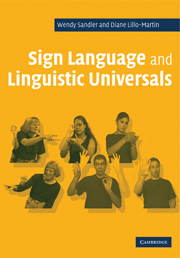Book contents
- Frontmatter
- Contents
- Preface
- Notation conventions
- UNIT I INTRODUCTION
- UNIT II MORPHOLOGY
- UNIT III PHONOLOGY
- UNIT IV SYNTAX
- 17 Syntax: introduction
- 18 Clausal structure
- 19 Clausal structure across sign languages
- 20 Variations and extensions on basic sentence structures
- 21 Pronouns
- 22 Topic and focus
- 23 WH-questions
- 24 Syntax: summary and directions
- UNIT V MODALITY
- References
- Index
17 - Syntax: introduction
Published online by Cambridge University Press: 05 June 2012
- Frontmatter
- Contents
- Preface
- Notation conventions
- UNIT I INTRODUCTION
- UNIT II MORPHOLOGY
- UNIT III PHONOLOGY
- UNIT IV SYNTAX
- 17 Syntax: introduction
- 18 Clausal structure
- 19 Clausal structure across sign languages
- 20 Variations and extensions on basic sentence structures
- 21 Pronouns
- 22 Topic and focus
- 23 WH-questions
- 24 Syntax: summary and directions
- UNIT V MODALITY
- References
- Index
Summary
Unit overview
Our aim throughout this book is to probe more deeply into the human capacity for language by seeking properties which are truly universal – those that hold for sign language as well as spoken language. In this unit, devoted to studies of sign language syntax, the goal is the same. Do sign languages respect the claimed universal properties of sentence structure? Where there are similarities, are the proposals that have been developed to account for universals adequate for encompassing sign languages as well? Where there are differences, can they be explained – not just described? In order to ask these questions, it is crucial that we begin here as in previous units with some kind of understanding of universals of spoken languages.
Over the past decades, many linguists have sought to understand the abstract properties which underlie all languages. These properties have been captured by a variety of mechanisms developed within a number of theoretical frameworks. We find that detailed, formal theories often provide an excellent starting point for our investigation, because they lead researchers to ask specific questions which might not otherwise come up. Thus, we concentrate largely on work conducted within such frameworks. In this unit in particular, most of the work we present has exploited the theoretical devices made available by generative grammar, as introduced by Chomsky (1957, etc.) and subsequently pursued by many others as well.
- Type
- Chapter
- Information
- Sign Language and Linguistic Universals , pp. 281 - 287Publisher: Cambridge University PressPrint publication year: 2006



